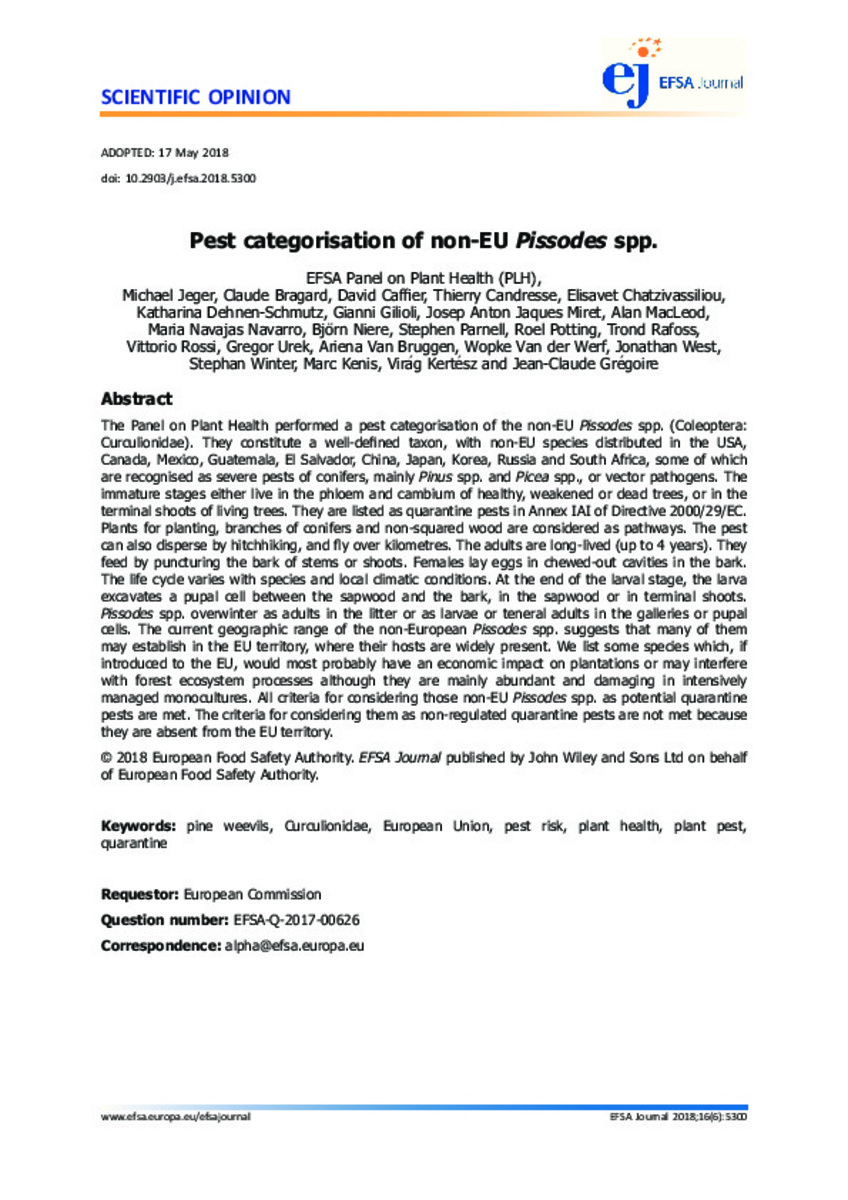Pest categorisation of non-EU Pissodes spp.

Ver/
Impacto
 Scholar |
Otros documentos de la autoría: Jeger, Michael; Bragard, Claude; Caffier, David; Candresse, Thierry; CHATZIVASSILIOU, ELISAVET; Dehnen-Schmutz, Katharina; Gilioli, Gianni; Jaques , Josep A.; MacLeod, Alan; Navajas Navarro, María; Niere, Björn; parnell, stephen; Potting, Roel; Rafoss, Trond; Rossi, Vittorio; Urek, Gregor; van Bruggen, Ariena; van der Werf, Wopke; West, Jonathan; Winter, Stephan; Kenis, Marc; Kertész, Virág; Grégoire, Jean-Claude
Scholar |
Otros documentos de la autoría: Jeger, Michael; Bragard, Claude; Caffier, David; Candresse, Thierry; CHATZIVASSILIOU, ELISAVET; Dehnen-Schmutz, Katharina; Gilioli, Gianni; Jaques , Josep A.; MacLeod, Alan; Navajas Navarro, María; Niere, Björn; parnell, stephen; Potting, Roel; Rafoss, Trond; Rossi, Vittorio; Urek, Gregor; van Bruggen, Ariena; van der Werf, Wopke; West, Jonathan; Winter, Stephan; Kenis, Marc; Kertész, Virág; Grégoire, Jean-Claude
Metadatos
Mostrar el registro completo del ítemcomunitat-uji-handle:10234/9
comunitat-uji-handle2:10234/2508
comunitat-uji-handle3:10234/6999
comunitat-uji-handle4:
INVESTIGACIONMetadatos
Título
Pest categorisation of non-EU Pissodes spp.Autoría
Fecha de publicación
2018-06-21Editor
European Food Safe Authority (EFSA)Cita bibliográfica
JEGER, Michael; BRAGARD, Claude; CAFFIER, David; CANDRESSE, Thierry; CHATZIVASSILIOU, Elisavet; DEHNEN-SCHMUTZ, Katharina; GILIOLI, Gianni; JAQUES, Josep A.; MACLEOD, Alan; NAVAJAS NAVARRO, María; NIERE, Björn; PARNELL, Stephen; POTTING, Roel; RAFOSS, Trond; ROSSI, Vittorio; UREK, Gregor; VAN BRUGGEN, Ariena; VAN DER WERF, Wopke; WEST, Jonathan; WINTER, Stephan; KENIS, Marc; KERTÉSZ, Virág; GRÉGOIRE, Jean-Claude (2018). Pest categorisation of non-EU Pissodes spp. EFSA Journal (2018), v. 16, n 6Tipo de documento
info:eu-repo/semantics/articleVersión de la editorial
https://www.efsa.europa.eu/en/efsajournal/pub/5300Versión
info:eu-repo/semantics/publishedVersionPalabras clave / Materias
Resumen
The Panel on Plant Health performed a pest categorisation of the non-EU Pissodes spp. (Coleoptera:
Curculionidae). They constitute a well-defined taxon, with non-EU species distributed in the USA,
Canada, Mexico, ... [+]
The Panel on Plant Health performed a pest categorisation of the non-EU Pissodes spp. (Coleoptera:
Curculionidae). They constitute a well-defined taxon, with non-EU species distributed in the USA,
Canada, Mexico, Guatemala, El Salvador, China, Japan, Korea, Russia and South Africa, some of which
are recognised as severe pests of conifers, mainly Pinus spp. and Picea spp., or vector pathogens. The
immature stages either live in the phloem and cambium of healthy, weakened or dead trees, or in the
terminal shoots of living trees. They are listed as quarantine pests in Annex IAI of Directive 2000/29/EC.
Plants for planting, branches of conifers and non-squared wood are considered as pathways. The pest
can also disperse by hitchhiking, and fly over kilometres. The adults are long-lived (up to 4 years). They
feed by puncturing the bark of stems or shoots. Females lay eggs in chewed-out cavities in the bark.
The life cycle varies with species and local climatic conditions. At the end of the larval stage, the larva
excavates a pupal cell between the sapwood and the bark, in the sapwood or in terminal shoots.
Pissodes spp. overwinter as adults in the litter or as larvae or teneral adults in the galleries or pupal
cells. The current geographic range of the non-European Pissodes spp. suggests that many of them
may establish in the EU territory, where their hosts are widely present. We list some species which, if
introduced to the EU, would most probably have an economic impact on plantations or may interfere
with forest ecosystem processes although they are mainly abundant and damaging in intensively
managed monocultures. All criteria for considering those non-EU Pissodes spp. as potential quarantine
pests are met. The criteria for considering them as non-regulated quarantine pests are not met because
they are absent from the EU territory. [-]
Publicado en
EFSA Journal (2018), v. 16, n. 6Derechos de acceso
info:eu-repo/semantics/openAccess
Aparece en las colecciones
- CAMN_Articles [566]
El ítem tiene asociados los siguientes ficheros de licencia:













